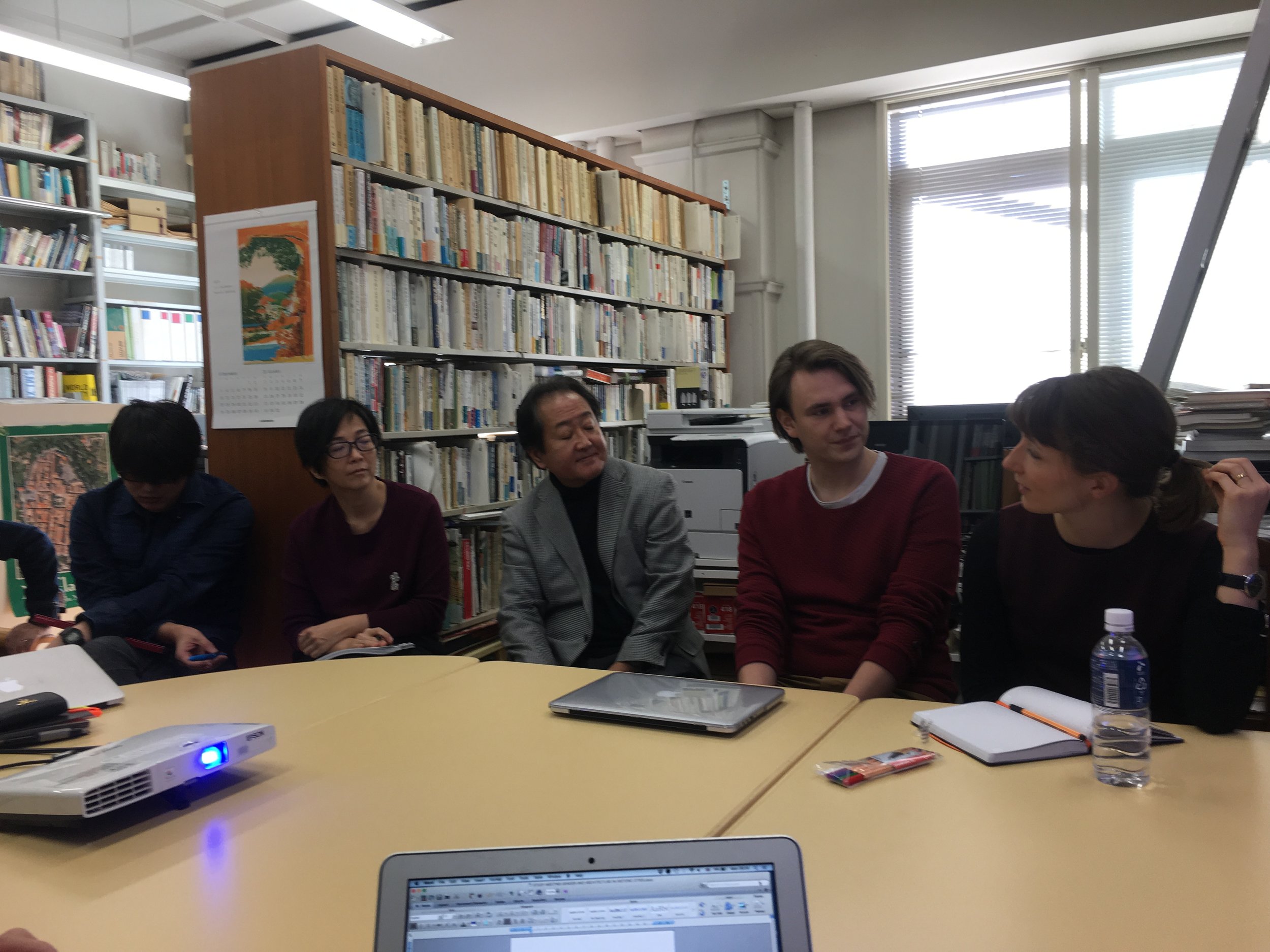Study meeting at the Ito Lab
PROJECT REPORT
Freedom of the Streets Project & (UvA)/Ito Lab (University of Tokyo) Joint Study Meeting
"Gender and Architecture in Historic Cities"
30 October 2017, 9:15-11:15
Takeshi Ito Laboratory, Graduate School of Engineering, University of Tokyo
Organizers: Dr. Danielle van den Heuvel & Dr. Bébio Amaro
The main purpose of this joint meeting was to discuss interdisciplinary approaches to gender and urban history in the context of early-modern Edo, as a preparatory step for the Freedom of the Streets' sub-project dedicated to the city of Edo. Furthermore, we aimed to establish contacts with promising up-and-coming researchers doing work in this field, and discuss the possibility of establishing a collaborative framework where people could discuss ideas, share data and help advance each other's research projects.
The meeting started with a brief self-introduction by everyone in attendance, as well as a short explanation of our aims in holding this event, followed by three presentations by the Freedom of the Streets project members, namely Danielle van den Heuvel, Bob Pierik and Antonia Weiss . Each presentation was an abridged version of the work being carried out by each member, which was fully shown at the GHC Global Conference from 28 to 29 October. Danielle van den Heuvel showcased the projects' main goals, and the official website which recently went online; Bob Pierik talked about his research on historical materials on the city of Amsterdam, especially how he was using criminal records and witness testimonies to reconstruct a database of the ordinary lives of the city's inhabitants. As for Antonia Weiss, she described her comparative project between the cities of Amsterdam and Berlin, focusing on their urban gardens (both private and public); she makes the case that the design of urban gardens/green spaces in both cities can be compared with the issue of women's freedom of movement outside of their homes, as well as their appropriation of urban spaces to express their identity.
Following this, Bébio Amaro gave a brief introductory presentation to the Edo sub-project, showcasing the preparatory work that had been done so far. The projects' aim is to investigate people's movements and their everyday actions in early-modern Edo, according to gender and social status. As a partner program to the Amsterdam project, it will adapt the previously prepared database to the context of Edo, which includes new types of natural disasters such as earthquakes and typhoons, as well as job occupations that cannot be found in Amsterdam. It will also adopt the methodology of verbal analysis to study people's activities and occupations.
Amaro then presented a list of historical materials that he intends to consult, namely diaries of men and women, legal regulations and prohibitions, paintings, travel guidebooks, maps and archaeological excavation reports; he discussed the main shortcomings of these materials, which can be summarized as follows:
1) women and low social classes are considerably under-represented in historical sources;
2) while men's diaries tend to feature detailed descriptions of their travel destinations and meetings, materials written by women are often less clear about their daily activities, and function instead as mediums to express their creativity in the forms of poetry or verse;
3) paintings made during the early modern period did not necessarily depict the streets of Edo in a realistic manner;
4) old maps need to be carefully georeferenced in order to match with current maps, which is a labor-intensive process.
After this, there was a presentation by doctoral candidate Hiroki Kominami, which dealt with the evolution of the Temple-Parish system during the late Edo and Meiji periods. This temple-parish system was originally established in the early 1600s across Japan as a form of carefully controlling the activities of people who may be secretly engaged in unauthorized cults, such as Christian religion; but it also quickly became a form of organizing communities into districts, for the purpose of mutual assistance and daily administrative management.
Hiroki Kominami explained how the establishment of temples initially defined a parish territory that was considerably fragmented/scattered, and barely extended beyond the confines of city roads. But as time passed, the boundaries of each parish gradually extended until they came across the boundaries of another parish. These boundaries could be defined by a number of factors, such as roads, topography, rivers, etc. Since the people living in each parish had to contribute a considerable number of services in support of the local temple, these administrative boundaries helped to establish a number of distinct group identities across Edo/Tokyo, thus constituting a form of urban heritage.
Kominami’s presentation was followed byboth questions and a general discussion of each other's projects. Among the issues discussed, we can point out: the high level of detail in historical sources of Amsterdam, as contrasted with the lower level of detail in Edo sources, which rarely mention more than street names; a comparison of paintings of Amsterdam and Western influences in some Edo painters; the topography of Edo, which includes both low-altitude regions, often inhabited by people of lower status, and higher-altitude regions where privileged people tended to live; discussions about how the Amsterdam project database works in practice; recommendation of books; open access to data; and possible approaches to the methodologies for both Amsterdam and Edo.



